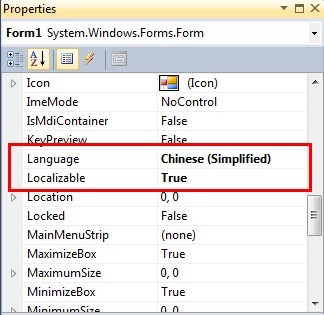
·您现在的位置: 云翼网络 >> 文章中心 >> 网站建设 >> 网站建设开发 >> ASP.NET网站开发 >> c#与winform界面开发
- C#系统应用之通过注册表获取USB使用记录(一)
- Chart控件使用初步
- 正则表达式系列
- .NET二维码生成(ThoughtWorks.QRCode)
- [C#]异步委托使用小计
- ASP.NET获取网站路径
- Net作业调度(四)—quartz.net持久化和集群
- Repeater事件OnItemCommand取得行内控件
- ASP.NET中文件上传下载方法集合
- ASP.NET2.0 WebRource,开发微调按钮控件
- 用异步缓存确保高流量网页及时更新与低错误率
- 邮箱mail 发送类 ASP.NET C#
- test1
- log4net日志的配置及简单应用
- ASP.Net2.0 WebPart趣味网页设计
- 基于ADODBX对数据库的CURD
- [.net 面向对象程序设计进阶] (17) 多线程(Multithreading)(二) 利用多线程提高程序性能(中)
- .NET XML序列化,框架类及使用
- 窗体DataGridView控件中按回车键时,单元格向下移动,如何能改成向右移动
- 命名规范(1)大小写约定
- 洗牌游戏
- 高级搜索插件solis search在umbraco中的使用
- 使用ASP.Net Forms模式实现WebService身份验证
- 数据库插入时碰到NULL报错判断的一种方法(技巧)
- 用ASP.NET 2.0在Oracle中存取图片(文件)的操作
- mvc中使用uploadify批量上传的应用
- 值类型与引用类型的简单测试,没有太多的理论,一目了然。
- Ext.Net动态加载多表头
- 解决 ASP.NET Chart 控件出错 为 ChartImg.axd 执行子请求时出错
- 最受欢迎的ASP.NET的CMS下载
c#与winform界面开发
在 windows 下使用 vs2010 开发,未深入研究。
c# 与 .net 开发,一堆又一堆的新名词,头晕目眩,比如 CLR / apartments / STA / MTA / COM
吐槽无力,只一个问题:微软真的是软件公司,而不是文学公司?
1. 工程代码结构
创建 Windows Forms application 工程后,自动生成如下代码:

Form1.cs 与 Form1.Designer.cs 是 2 个文件,一起定义了一个 form 的行为/样式等。在 vs2010 中会折叠在一起。
其中,Designer 中定义样式。事件监听、事件处理都在 form.cs 中定义。
双击 form.cs 会打开 UI 效果界面,可以直接拖拽完成界面布局。右键 view code 可以查看 form1.cs 源码。
PRogram.cs 内定义了 main 函数,是启动文件。
用一个 App run 一个 form。
[STAThread]/[MTAThead] 指定单/多线程运行模式。
using System;
using System.Collections.Generic;
using System.Linq;
using System.Windows.Forms;
namespace AppDemo
{
static class Program
{
/// <summary>
/// The main entry point for the application.
/// </summary>
[STAThread]
static void Main()
{
Application.EnableVisualStyles();
Application.SetCompatibleTextRenderingDefault(false);
Application.Run(new Form1());
}
}
}
2. Form.cs 与 Form.Designer.cs
form1.cs 与 designer.cs 2个文件定义的是同一个 namespace 下的 同一个 class
每一个文件定义时,都使用了 partial class
界面布局的代码,一般自动生成,在 Designer 中。
手写的代码主要是事件处理,一般放在 form.cs 中
form.cs 的构造函数中,一般会先调用 Designer.cs 中定义的 InitializeComponent() 完成界面初始化。
在 InitializeComponent 中会声明每个控件的索引 private System.Windows.Forms.Button button1;
在 form.cs 中可以直接用过变量名 button1 操作该控件。
所以,form.cs 的构造函数中,一般先调用 InitializeComponent。
Designer.cs 中,InitializeComponent 初始化界面。Dispose 方法释放资源。释放时需要注意不要造成资源泄露。
// --------------- Form1.cs -----------------------------------
using System;
using System.Collections.Generic;
using System.ComponentModel;
using System.Data;
using System.Drawing;
using System.Linq;
using System.Text;
using System.Windows.Forms;
namespace AppDemo
{
public partial class Form1 : Form
{
public Form1()
{
InitializeComponent();
}
}
}
// ------------------- Form1.Designer.cs -------------------------
namespace AppDemo
{
partial class Form1
{
/// <summary>
/// Required designer variable.
/// </summary>
private System.ComponentModel.IContainer components = null;
/// <summary>
/// Clean up any resources being used.
/// </summary>
/// <param name="disposing">true if managed resources should be disposed; otherwise, false.</param>
protected override void Dispose(bool disposing)
{
if (disposing && (components != null))
{
components.Dispose();
}
base.Dispose(disposing);
}
#region Windows Form Designer generated code
}
}
3. 资源文件 与 resx
exe 或者 dll 文件需要依赖其它文件得以正常运行,
最简单的做法是:把依赖文件拷贝到客户端,程序内部用相对路径读取。
这一般是可以的,但若客户删除了这些资源,则会导致不可预期的效果。
通过资源文件,可以把这些文件嵌入到 exe 或者 dll 中。
资源文件可分为 2 类:.resx 和 .resources。前者是 xml 格式,后者是二进制。
只有当前 solution 存在同名的 .cs 文件时,.resx 文件才能正常工作。resources 则无此限制。
通过 System.Resources 下的 ResourceWriter 可以生成资源文件,Generate 产生文件,Close 关闭文件。
创建实例后,即可通过 AddResource 方法添加资源。第一个参数是标示符,可以在代码中通过标示符使用资源。
资源文件中一般存三种类型的数据:byte流(byte[])、对象(object)和字符串(string)。
ResourceWriter rw = new ResourceWriter ( "filename.resources" ) ; rw.Generate ( ) ; // 产生文件 rw.Close ( ) ; // 添加资源 public void AddResource ( str_identifier , byte [ ] ) ; public void AddResource ( str_identifier , object ); public void AddResource ( str_identifier , str_value ) ;
resources.ApplyResources( this.myButton, str_identifier ); // 为 this.myButton 使用资源 str_identifier
this.ApplyResource();
4. 多国语言与本地化
4.1 添加多国语言支持
在界面上添加组件后,会生成 .resx 文件,vs2010 中折叠在对应的 form.cs 下。
这是默认语言的资源文件,文件名为 form1.resx
若要开发其他语言版本,在对应 form 右侧的属性菜单中,将 Localizable 设为 True,并将 language 设为所需语言即可。
设置新的显示文本后保存,会生成对应语言的 .resx 文件。文件名格式为 form1.language-Location.resx,例如:简体中文为 form1.zh-CN.resx
- 仅当 Language 为 default 时才可以添加或删除界面中的组件。
- 仅当设定为新 language,且修改过显示内容后,才会创建对应的资源文件。
- 仅当选定 form 时,才能在右侧属性菜单中设置语言。若选中 form 中的 button、text 等组件时,无法设置本地化属性。
- 添加多国语言支持后,默认语言的 form1.resx 中不再包含显示文字 Text、控件大小 Size、显示位置 Location 等,而是放在了对应语言的资源文件中,通过 ApplyResources 取用。

4.2 获取与设定运行时语言
两个关键概念:
- CurrentCulture:默认值是操作系统的用户区域设置,它在“区域选项”控制面板中设置。
- CurrentUICulture: 默认值是操作系统的用户界面 (UI) 语言,即操作系统用户界面所使用的语言。
System.Globalization.CultureInfo.InstalledUICulture.Name; // 获取当前运行语言 System.Threading.Thread.CurrentThread.CurrentUICulture = new System.Globalization.CultureInfo( "zh-CHS" ); // 设置当前运行语言
5. 页面布局与样式设定
SuspendLayout() 调用后控件的布局逻辑被挂起,直到调用 ResumeLayout() 方法为止。
当调整控件的多个属性时,将先调用 SuspendLayout 方法,然后设置控件的 Size、Location、Anchor 或 Dock 属性,
最后调用 ResumeLayout 方法以使更改生效。
- 上一篇文章: .NET工程师必须掌握的知识点
- 下一篇文章: 提升开发效率的十个工具
- LINQtoObjects系列(3)深入理解Lambda表达式
- 通过预加载器提升网页加载速度
- 私有构造函数的特点和用途
- IISExpress配置文件的一个坑
- 对.NET Framework 反射的反思
- asp.net利用Google接口实现拼写检查
- Code First, Database First, Same Time区别